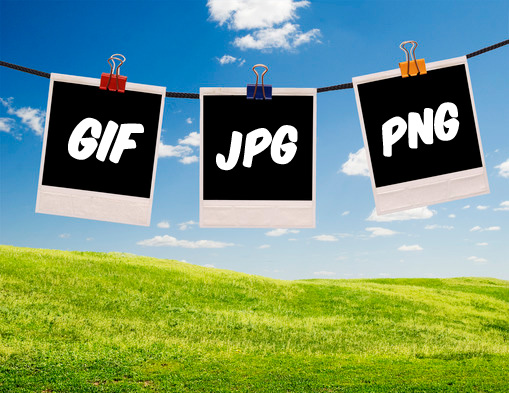Have you ever really wondered what the difference between JPEG, GIFF and PNG are? Well hopefully this will explain…
GIF: Graphics Interchange Format
GIF is by nature an 8-bit color file, meaning they are limited to a palette of 256 colors, which can be picked from the RGB color model and saved to a Color Look Up Table (CLUT), or simply “Color Table.” There are, however, standard color palettes, like the “Web Safe” palette. An important note is that Grayscale images are by nature an 8-bit palette, so saving them as GIF is fairly ideal. Apart from support for transparency, GIF also is supports animations, limiting every frame to 256 preselected colors.
JPEG: Joint Photographic Experts Group
JPG was a filetype developed by the Joint Photographic Experts Group (JPEG) to be a standard for professional photographers. Like the method ZIP files use to find redundancies in files to compress data, JPGs compress image data by reducing sections of images to blocks of pixels or “tiles.” JPG compression has the unfortunate side effect of being permanent, however, as the technology for the file was created for storing large photographic image files in surprisingly small spaces, and not for photo editing.
A typical JPG can be compressed at a ratio of anywhere from 2:1 to as high as 100:1, depending on your settings. Particularly back in the days of dial-up internet, JPGs were the only viable way to send image information.
However, because of the lossy nature of JPG, it is not an ideal way to store art files. Even the highest quality setting for JPG is compressed, and will change the look of your image, if only slightly. JPG is also not an ideal medium for typography, crisp lines, or even photographs with sharp edges, as they are often blurred or smeared out by anti-aliasing. What is potentially worse, is that this loss can accumulate—saving multiple versions of artwork can cause degradation with every save. Even so, it is common to see these things saved as JPG, simply because the filetype is so ubiquitous.
PNG: Portable Network Graphics
PNG stands for Portable Network Graphics It was developed as an open alternative to GIF, which used the proprietary LZW compression algorithm discussed earlier. PNG is an excellent filetype for internet graphics, as it supports transparency in browsers with an elegance that GIF does not possess. Notice how the transparent color changes and blends with the background. Right-click the image to see. This is actually one image that is on four different background colors.
PNG supports 8-bit color like GIF, but also supports 24-bit color RGB, like JPG does. They are also non-lossy files, compressing photographic images without degrading image quality. PNG tends to be the biggest of the three filetypes and isn’t supported by some (usually older) browsers.
In addition to being an excellent format for transparency, the non-lossy nature of 24-bit PNG is ideal for screenshot software, allowing pixel for pixel reproduction of your desktop environment.
Hope that helps any questions just ask!
Mark Williams is the Director of Creative Studios Derby LTD, the East Midlands largest and most experienced Adobe training centre. If you need help learning any software from the Adobe Creative Suite, then contact us.
We regularly run Adobe InDesign Training Courses, Adobe Illustrator Training Courses and Adobe Photoshop Training Courses from our state of the art studio in Derby.

 Click here to see all of our Software Training Courses
Click here to see all of our Software Training Courses

One thought on “What’s the difference between JPEG, GIFF and PNG”